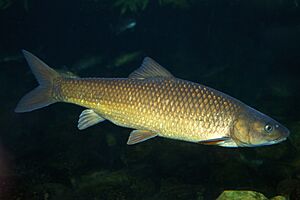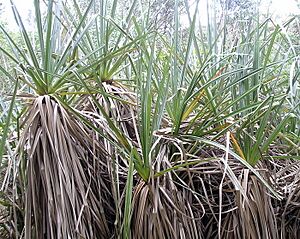Clanwilliam yellowfish facts for kids
The Clanwilliam yellowfish (Labeobarbus seeberi) is a special type of ray-finned fish that belongs to the carp family, Cyprinidae. It's often called a "yellowfish" because the males turn a beautiful golden-yellow color during their breeding season. This fish is found only in the Western Cape Province of South Africa.
Quick facts for kids Clanwilliam yellowfish |
|
|---|---|
 |
|
| Conservation status | |
| Scientific classification | |
| Synonyms | |
|
When they are young, these fish are silvery with dark stripes on their sides. As they grow older, they become light brown. Like other yellowfish, the Clanwilliam yellowfish can grow quite large.
Contents
Where They Live and What They Do
The Clanwilliam yellowfish lives only in the Western Cape Province of South Africa. You can find them in the smaller rivers that flow into the Olifants River. These include rivers like the Doring River, Biedou, and Groot in the Cederberg Mountains. It's not clear if many still live in the Olifants River itself. They seem to have disappeared from some parts of it.

These fish prefer rivers and streams where the water moves well. They don't like water that moves too slowly. Young Clanwilliam yellowfish, less than 4 centimeters (1.6 inches) long, often hide in calm areas or shallow, fast-flowing parts of the river. As they get bigger, they move to deeper water. However, even adult fish can still be found in shallower spots.
Deep pools and thick stands of Palmiet plants (a type of plant that grows near rivers) are very important for their survival. These plants provide shade and help the fish survive if their rivers start to dry up during hot summers.
What They Eat and How They Breed
Young Clanwilliam yellowfish eat tiny water animals like zooplankton. Adult fish are omnivores, meaning they eat both plants and animals. They feed on larger water insects and algae.
Their breeding season lasts from late spring to summer, usually from October to December. During this time, the water needs to be at least 20°C (68°F). Adult fish swim in small groups into shallow, fast-flowing areas of the river. The water here is only a few decimeters deep. They lay their eggs there, which are not sticky. The baby fish, called hatchlings, hide among the rocks and gravel at the bottom of the river. If they can't find perfect breeding spots, like in dams, they will use any shallow water with plenty of rocks.
Why They Need Our Help
The number of Clanwilliam yellowfish has dropped a lot since the 1940s. This happened after other fish, like the smallmouth bass, were brought into their rivers. The bass eat the young Clanwilliam yellowfish, which can cause their numbers to disappear in some areas. Other types of bass and bluegills also compete with young yellowfish for food.
Besides these new fish, their homes are also being damaged. Rivers are changed by building canals and dams. Water pollution from pesticides and fertilisers from farms also harms them. Because of these threats, the Clanwilliam yellowfish is listed as Near Threatened by the IUCN. This means they could become endangered if we don't protect them.
Protecting the Clanwilliam Yellowfish
It is against the law to kill Clanwilliam yellowfish in the Western Cape Province. You can only catch them for special research projects or to move them to new areas.
The fish live in protected places like the Cederberg Wilderness Area. A larger area called the Greater Cederberg Biodiversity Corridor was set up in 2004. This helps local landowners use the land in ways that protect nature.
In 1976, a special station was created to breed these fish in captivity. This program helped raise thousands of young Clanwilliam yellowfish. These fish were then used to help start new populations in rivers.
A group called the National Yellowfish Working Group was started in 1997. They continue the work of the breeding program and teach people about the importance of these fish. There's also a big program called Cape Action for People and the Environment. It aims to remove harmful non-native fish from the rivers in the Cape Floristic Region. This will help the Clanwilliam yellowfish and other native fish recover.


